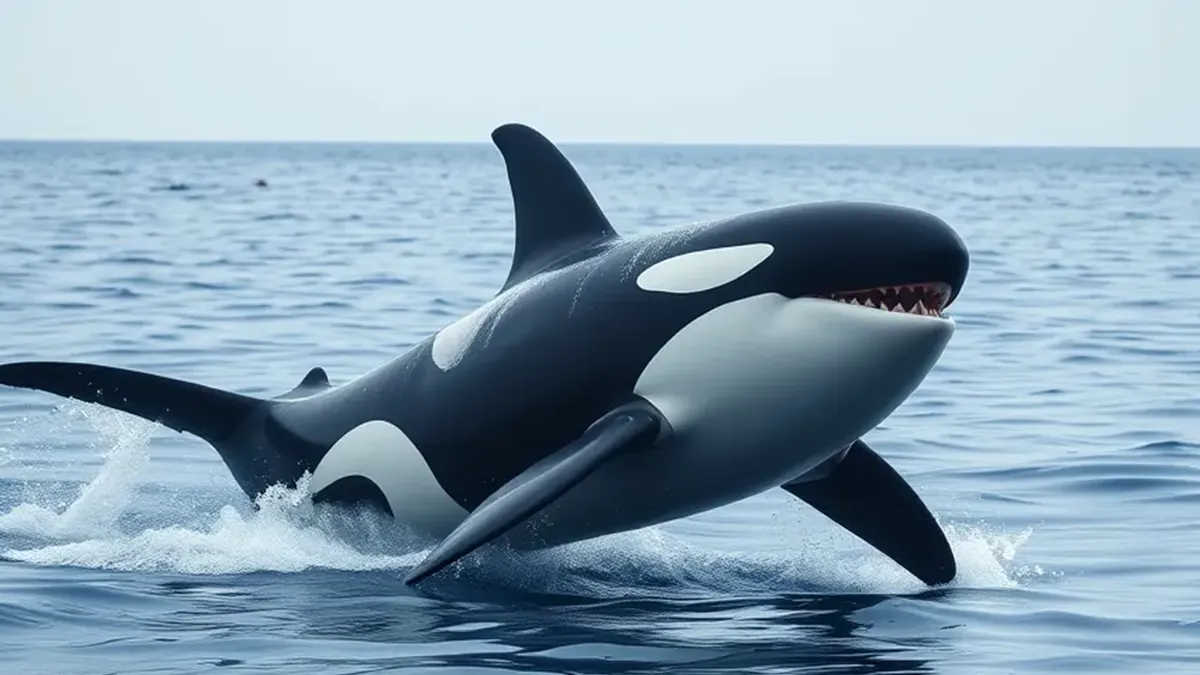Killer whales, or orcas, are some of the most fascinating creatures in the ocean, known for their intelligence, strength, and sleek black-and-white appearance. But when people look at orcas, one common question arises: Where are their eyes? In this article, we’ll dive deeper into the unique anatomy of these apex predators, explaining not just where their eyes are, but also how their vision works, and what makes it so special in the underwater world.
Table of Contents
Understanding Orca Eye Placement
At first glance, it might seem like orcas don’t even have eyes! Their sleek, black-and-white color patterns can be misleading, but their eyes are there, just subtly placed. Orca eyes are located just below and in front of their white eye patches, blending in with the dark black skin of their heads.
Why this unique placement?
The position of their eyes serves an important purpose. It helps protect their eyes while they swim at high speeds and hunt, reducing the chance of injury from prey or debris in the water. Plus, with their streamlined bodies, orcas are built for efficient movement through water, and their eye placement complements this design perfectly.
How Orca Vision Works: More Than Meets the Eye
While orcas may not rely on their vision as heavily as some animals (thanks to their echolocation abilities), their eyesight is still impressive. Orcas have excellent vision both in and out of water, which is crucial for hunting and navigating the ocean depths.
Orcas and underwater vision
Orcas’ eyes are specially adapted to see well in the low-light environments of the deep sea. Their retinas contain a higher proportion of rod cells, which are responsible for vision in dim lighting. This allows them to spot prey even in the darker layers of the ocean.
Surface vision abilities
Above the water, orcas also have good eyesight, but since they rely more on echolocation, they’re not as dependent on surface vision. Still, their eyes can adjust quickly between air and water, making them versatile hunters.
Orcas’ Use of Echolocation: The Ultimate Hunting Tool
While their vision is impressive, orcas’ main superpower comes from their echolocation abilities. Orcas can emit sound waves and listen to the echoes that bounce back from objects or animals around them. This gives them a precise understanding of their surroundings, allowing them to hunt in murky waters or complete darkness where eyesight alone would fail.
How echolocation works
Orcas send out clicks and other sounds from their blowholes. These sound waves travel through the water and bounce off any nearby objects. When the sound returns, orcas interpret the echoes to determine the size, shape, and even the distance of their target. This makes echolocation their primary sense for locating prey.
Eyes vs. echolocation: When do orcas use each?
While vision helps orcas in daylight or when they’re near the surface, echolocation is their go-to sense when navigating deeper waters or hunting prey that’s out of sight. The combination of both senses makes them incredibly efficient predators.
Do Orcas Have Color Vision?
A fascinating aspect of orca vision is the debate about whether they can see colors. It’s believed that orcas are dichromatic, meaning they only see two colors—likely shades of blue and green. This is common among marine mammals because, underwater, the color red is quickly absorbed, leaving mostly blues and greens.
How does this impact orcas?
Since the underwater environment is dominated by these two colors, it doesn’t seem to limit them at all. Instead, their vision and echolocation work hand-in-hand to help them survive and thrive in their aquatic world.
Why Do Orcas Have Eye Patches?
One of the most recognizable features of killer whales is their striking white eye patches. However, these patches don’t mark the actual position of their eyes. Instead, they may serve as a form of camouflage or social signaling. The high contrast between their black bodies and white patches helps break up their silhouette in the water, making it harder for prey to recognize them as a threat.
Other potential purposes
Some researchers also suggest that the eye patches may play a role in orca communication. Since orcas are social animals, the distinctive white patches might help them identify one another in a pod or signal intentions during cooperative hunts.
Title: Where Are Orca Eyes? Uncovering the Hidden Vision of Killer Whales
Killer whales, or orcas, are some of the most fascinating creatures in the ocean, known for their intelligence, strength, and sleek black-and-white appearance. But when people look at orcas, one common question arises: Where are their eyes? In this article, we’ll dive deeper into the unique anatomy of these apex predators, explaining not just where their eyes are, but also how their vision works, and what makes it so special in the underwater world.
Understanding Orca Eye Placement
At first glance, it might seem like orcas don’t even have eyes! Their sleek, black-and-white color patterns can be misleading, but their eyes are there, just subtly placed. Orca eyes are located just below and in front of their white eye patches, blending in with the dark black skin of their heads.
Why this unique placement?
The position of their eyes serves an important purpose. It helps protect their eyes while they swim at high speeds and hunt, reducing the chance of injury from prey or debris in the water. Plus, with their streamlined bodies, orcas are built for efficient movement through water, and their eye placement complements this design perfectly.
How Orca Vision Works: More Than Meets the Eye
While orcas may not rely on their vision as heavily as some animals (thanks to their echolocation abilities), their eyesight is still impressive. Orcas have excellent vision both in and out of water, which is crucial for hunting and navigating the ocean depths.
Orcas and underwater vision
Orcas’ eyes are specially adapted to see well in the low-light environments of the deep sea. Their retinas contain a higher proportion of rod cells, which are responsible for vision in dim lighting. This allows them to spot prey even in the darker layers of the ocean.
Surface vision abilities
Above the water, orcas also have good eyesight, but since they rely more on echolocation, they’re not as dependent on surface vision. Still, their eyes can adjust quickly between air and water, making them versatile hunters.
Orcas’ Use of Echolocation: The Ultimate Hunting Tool
While their vision is impressive, orcas’ main superpower comes from their echolocation abilities. Orcas can emit sound waves and listen to the echoes that bounce back from objects or animals around them. This gives them a precise understanding of their surroundings, allowing them to hunt in murky waters or complete darkness where eyesight alone would fail.
How echolocation works
Orcas send out clicks and other sounds from their blowholes. These sound waves travel through the water and bounce off any nearby objects. When the sound returns, orcas interpret the echoes to determine the size, shape, and even the distance of their target. This makes echolocation their primary sense for locating prey.
Eyes vs. echolocation: When do orcas use each?
While vision helps orcas in daylight or when they’re near the surface, echolocation is their go-to sense when navigating deeper waters or hunting prey that’s out of sight. The combination of both senses makes them incredibly efficient predators.
Do Orcas Have Color Vision?
A fascinating aspect of orca vision is the debate about whether they can see colors. It’s believed that orcas are dichromatic, meaning they only see two colors—likely shades of blue and green. This is common among marine mammals because, underwater, the color red is quickly absorbed, leaving mostly blues and greens.
How does this impact orcas?
Since the underwater environment is dominated by these two colors, it doesn’t seem to limit them at all. Instead, their vision and echolocation work hand-in-hand to help them survive and thrive in their aquatic world.
Why Do Orcas Have Eye Patches?
One of the most recognizable features of killer whales is their striking white eye patches. However, these patches don’t mark the actual position of their eyes. Instead, they may serve as a form of camouflage or social signaling. The high contrast between their black bodies and white patches helps break up their silhouette in the water, making it harder for prey to recognize them as a threat.
Other potential purposes
Some researchers also suggest that the eye patches may play a role in orca communication. Since orcas are social animals, the distinctive white patches might help them identify one another in a pod or signal intentions during cooperative hunts.
Orca Vision Compared to Other Marine Mammals
Orcas aren’t the only marine mammals with fascinating vision capabilities. Dolphins, for example, also have eyes adapted for underwater vision, but their use of echolocation is even more prominent. Meanwhile, seals and sea lions rely more heavily on vision, especially since they spend more time near the water’s surface.
How orca vision stands out
What sets orcas apart is their ability to combine both eyesight and echolocation effectively. They don’t rely solely on one sense, but rather use a balance of both depending on their environment and hunting needs.
Final Thoughts: Seeing the Ocean Through Orca Eyes
While orcas’ eyes may be small and hidden compared to other large animals, they play a vital role in how these predators interact with their surroundings. From their impressive underwater vision to their use of echolocation, orcas have evolved to be master hunters in the ocean.
If you ever spot an orca in the wild, you’ll know exactly where to look to find their eyes—and appreciate the incredible adaptations that make them such formidable creatures of the sea.







